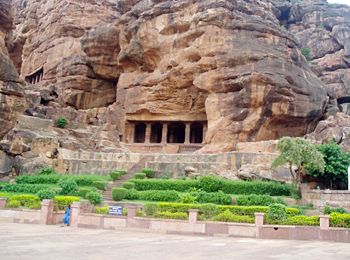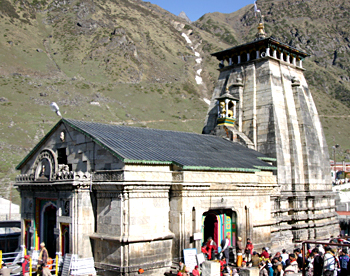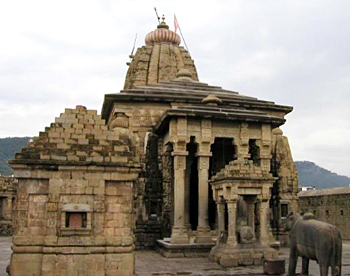 Shiva temples in India are the major places of attractions for pilgrims coming from different corners of the country. Lord Shiva is considered to be one of the most significant Hindu pantheons. There are several temples in India which are devoted to the Lord Shiva. The Lord is considered to be very kind and he is famous for obliging his devotees and therefore, he is also called as Bhole Shankar. The Indian Shiva temples also display a remarkable architectural design and thus attract a large number worshippers as well as tourists.
Shiva temples in India are the major places of attractions for pilgrims coming from different corners of the country. Lord Shiva is considered to be one of the most significant Hindu pantheons. There are several temples in India which are devoted to the Lord Shiva. The Lord is considered to be very kind and he is famous for obliging his devotees and therefore, he is also called as Bhole Shankar. The Indian Shiva temples also display a remarkable architectural design and thus attract a large number worshippers as well as tourists. One of the most prominent Shiva temples in India is the Kashi Vishwanath temple situated in the oldest existing city in the world, Varanasi. The word `Kashi` is derived from the word `Kas`. The meaning of Kas is to shine. There is repetitive mention of the word Kashi in the scriptures like the Upanishads, Brahmanas and the Puranas. The oldest center of learning in India is Kashi and its University is famous even today for its Philosophy, Sanskrit and Arts faculties. In the 7th century, the Chinese traveler by the name of Hyuen Tsang visited Varanasi. Filled abundantly with mythological legacy and tradition, Kashi is believed to be the original ground formed by Goddess Parvati and Lord Shiva. The Kashi Vishwanath Temple in Varanasi is devoted to the Lord Shiva. The temple was destroyed due to several invasions in the past and it was again reconstructed by Rani Ahilyabai of Indore in the year 1776. The Kashi Vishwanath temple is a living example of Indian spiritual values, tradition and culture. This temple in Varanasi is a witness to the visit of several renowned saints like Ramkrishna Paramhansa, Adi Shankaracharya, Goswami Tulsidas, Swami Vivekananda, Swami Dayanand Saraswati, Guru Nanak and a number of other renowned spiritual personalities.
Another well-known Shiva temple in India is the Amarnath cave temple which is located at a distance of about 145 km towards the east of Srinagar in Kashmir. The major attraction for the devotees here is the ice Silva linga which changes its shape and size with the change in season. With the waning and waxing of the Moon, the Linga changes its size and becomes smaller and bigger. The height of the linga attains a height of 6 ft on a full moon day. Every year, on a full moon day, which falls between July and August, the Shiva linga achieves its maximum height. At this time of the year, a festival is organized at this cave temple dedicated to the lord Shiva. There is a belief that the Lord Shiva appeared first on this auspicious day. This cave temple is situated at a height of 4,175meters or 13,700 ft. The height of the cave is 150 feet and 90 feet in length. There are about four or five formations on ice inside the cave apart from the main deity which resembles different Gods. An ice formation towards the left of the main deity is regarded as Ganesha and towards the right of the Lord Shiva there is a formation of Bhairava as well as Parvati. The entire place is blanketed with snow from the month of September to June every year. This cave temple opens for the pilgrims only in the month of July and August. Around 25,000 people take part in this Hindu pilgrimage every year. Amarnath Yatra is regarded as the most famous events taking place in the month of July and August. Thousands of Hindu pilgrims from different parts of this world take part in this annual Hindu event. There is a saying that Lord Shiva narrated to his consort Parvati the mystery at Amarnath, inside a cave. Without their knowledge, two mating doves overheard the entire conversation. After knowing the secret they are born again and again and thus have made that cave their resting place. Several pilgrims tell that they have seen a pair of doves while they were trekking the difficult route to get to the Ice Shiva lingam at Amarnath cave.
 There is an interesting story behind the discovery of this cave at Amarnath. There was a Gujjar or a shepherd by the name of Buta Malik. The shepherd was given a bag completely filled with coal by a saint, but when the shepherd opened the bag after reaching home, he found that the bag was entirely filled with gold coins. Thus delighted with joy he ran to expresses his sincere gratitude to the saint who gave him the bag. But Buta Malik could only find the cave and the Shiva Lingam there. He gave this message to the villagers and is said that from that day, the place has become one of the most sacred places of worship for the Hindus all over the world. There is another story with regard to the Amarnath cave temple which is narrated by an ancient epic. According to the epic, the Kashmir valley was previously under water and it was in the form of a large lake. The great Rishi Kashyap drained the water of the lake through several rivulets and rivers. At that time Bhrigu Rishi visited the Himalayas and he was also considered to be the first person to have a glimpse of the holy cave. And from then onwards the cave temple at Amarnath became a holy place for the Hindus.
There is an interesting story behind the discovery of this cave at Amarnath. There was a Gujjar or a shepherd by the name of Buta Malik. The shepherd was given a bag completely filled with coal by a saint, but when the shepherd opened the bag after reaching home, he found that the bag was entirely filled with gold coins. Thus delighted with joy he ran to expresses his sincere gratitude to the saint who gave him the bag. But Buta Malik could only find the cave and the Shiva Lingam there. He gave this message to the villagers and is said that from that day, the place has become one of the most sacred places of worship for the Hindus all over the world. There is another story with regard to the Amarnath cave temple which is narrated by an ancient epic. According to the epic, the Kashmir valley was previously under water and it was in the form of a large lake. The great Rishi Kashyap drained the water of the lake through several rivulets and rivers. At that time Bhrigu Rishi visited the Himalayas and he was also considered to be the first person to have a glimpse of the holy cave. And from then onwards the cave temple at Amarnath became a holy place for the Hindus. Among numerous Shiva temples in India, Lingaraja temple in the city of Bhubaneshwar is one of the most splendid work of art in stone with its remarkable architectural designs. This temple possesses a fifty four meter tower overlooking the landscape. Enclosed by tall walls from all directions, this is an architectural wonder of the 11th century. The outer surface of the walls of this temple display spectacular carvings. Delicately sculpted and carved images of Gods and Goddesses in this temple have no comparison. There are three compartments inside the temple complex and each compartment possesses a temple. The image of Lord Ganesha is there towards the south of the entrance of the main temple and the image of Goddess Parvati is there at the back. The image of Lord Kartikeya is to the north of the entrance. The beauty of the temple is enhanced with the presence of several halls and pillars.
The Somnath temple, Gujarat is another significant Shiva temple in the Indian subcontinent. It is also regarded as one of the twelve Jyotirlingas of Lord Shiva located at a distance of about 79 kilometers away from Junagadh and at a distance of 25 kilometers from Chorwad. As per legend, the Somnath temple is considered to be as old as creation. It is said that the temple has been constructed by the Moon God. Presently the remains of this temple have resisted the wrath of time and also lasted various attacks of destroyers.
 The architectural design of the Somnath temple is marvelous and it is situated beautifully in a place overlooking the Arabian Sea. As per Hindu mythology the name of moon is Soma who is the son-in-law of Daksha. Soma, on an occasion, did not obey a certain instruction given to him by Daksha. Daksha got agitated and thus angrily he cursed Soma. The curse was that; `Thou shalt wane!` Thus, the moon that used to shine previously with full glow started to shrink. Finding the moon in a miserable condition several Gods and Goddesses prayed before Daksha to take back his curse. Hence Daksha asked Soma to bath at the meeting point of the river Saraswati with the sea and then to worship Lord Shiva. Thus Shiva came to be worshipped as Lord Somanath or the Lord of the moon.
The architectural design of the Somnath temple is marvelous and it is situated beautifully in a place overlooking the Arabian Sea. As per Hindu mythology the name of moon is Soma who is the son-in-law of Daksha. Soma, on an occasion, did not obey a certain instruction given to him by Daksha. Daksha got agitated and thus angrily he cursed Soma. The curse was that; `Thou shalt wane!` Thus, the moon that used to shine previously with full glow started to shrink. Finding the moon in a miserable condition several Gods and Goddesses prayed before Daksha to take back his curse. Hence Daksha asked Soma to bath at the meeting point of the river Saraswati with the sea and then to worship Lord Shiva. Thus Shiva came to be worshipped as Lord Somanath or the Lord of the moon. Eklingji temple is regarded as the most sacred temples in India and it is also famous as the protector deity of Mewar. This temple dedicated to the Lord Shiva is situated at a distance of about twelve miles towards the north of Udaipur, Rajasthan in India. The deity at Eklingji temple was considered to be the main ruler by the Mewar Maharajas and they treat themselves as the dewans or regents under the Lord Eklingji. Situated in a very beautiful town of Rajasthan, the Eklingji temple pulls several thousand visitors. It is said that this temple was erected by Acharya Viswaroopa who lived during the time of Adi Sankaracharya and is also connected to the Sharada Math at Dwaraka which was constructed by Adi Sankaracharya. Eklingji temple spreads over an area of 2500 sq. feet and its height is about 65 feet. The entire area of the temple is protected by massive walls from all sides and the entrance to this temple welcomes its visitors into a large hall leaning on extravagantly carved pillars. A silver image of Nandi is displayed in this big hall. There are also two images of Nandi in the Eklingji temple; one made of brass and the other made of black stone. Several other deities found in this temple complex include Ganesha, Parvati, Kartikeya, Ganga, Saraswati and Yamuna. A number of other small temples devoted to Kalka Mata, Ambamata and Ganesha are there inside the temple complex. One temple called the Nathon Ka Mandir is there inside the temple complex bearing inscription which dates back to the 10th century CE. In this temple no worship is done.
Shiva temples in India are the places of great religious and spiritual importance. Devotees from all corners of the country and various other parts of the world visit these temples to worship their Lord Shiva and take his blessings. Some of the famous Indian Shiva temples are Baijnath Temple, Kedarnath, Rameshwaram Temples, Thanjavur Temples, Badami Cave Temples, Sthaneshwar Mahadev Temple, Mukteswara Temple, Bull Temple, Sri Chandeshwar Temple, Gundala Mallikarjuna Swami Temple, Sri Manguesh Temple, Shankeshwar Temple, Bhutanath Temple, Bijli Mahadev Temple, Sudh Mahadev, Lakha Mandal Temple, Vaikom Temple, Parasurameswara Temple, Leaning Temple, etc.

I really appreciate your post.Thank you once again...................Sthapati Architects, Specialises in Traditional architecture in Chennai. We have also designed Temple architecture in Chennai.
ReplyDeleteTraditional Architecture In Chennai
तीर्थ स्थल पर पार्थिव शिवलिंग का निर्माण करके उसकी पूजा अर्चना करना बहुत शुभ माना जाता है .
ReplyDelete